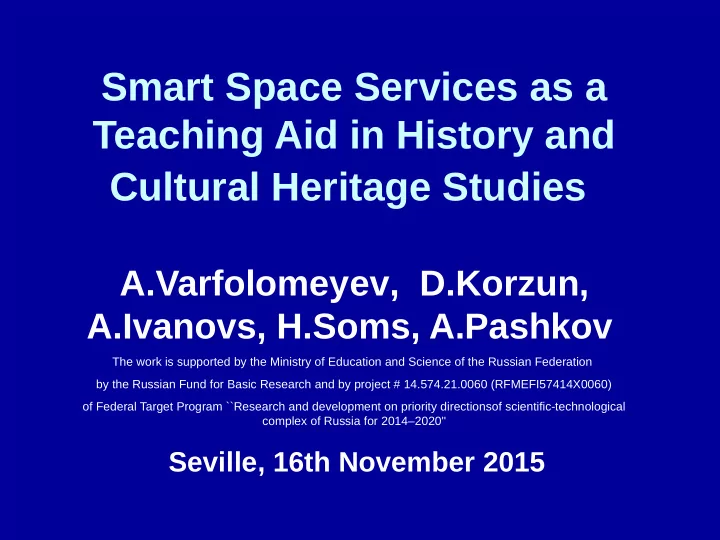

Smart Space Services as a Teaching Aid in History and Cultural Heritage Studies A.Varfolomeyev, D.Korzun, A.Ivanovs, H.Soms, A.Pashkov The work is supported by the Ministry of Education and Science of the Russian Federation by the Russian Fund for Basic Research and by project # 14.574.21.0060 (RFMEFI57414X0060) of Federal Target Program ``Research and development on priority directionsof scientific-technological complex of Russia for 2014–2020'' Seville, 16th November 2015
Main idea
Historical education needs • The curricula in history put a noticeable accent on practical acquisition of theoretical knowledge. However, acquisition of theoretical approaches in historical research and memorizing historical facts, persons, dates, and place names during study practices do not mean that students are able to comprehend and reconstruct synchronic and/or diachronic relations between historical events and diverse historical objects and to provide a multi-faceted representation of history.
Suggestion • To our mind, smart space services designed for historical tourism (so-called “Smart Personal Assistant”) might, to a certain extent, solve the aforementioned problem and promote the practical orientation in history teaching
Smart Personal Assistant (SPA) for Historical Tourism • Varfolomeyev, A., Korzun, D., Ivanovs, A., Petrina, O. (2014). Smart Personal Assistant for Historical Tourism. Recent Advances in Environmental Sciences and Financial Development. Proceedings of the 2nd International Conference on Environment, Energy, Ecosystems and Development (EEEAD 2014) (eds. C. Arapatsakos, M. Razeghi, V. Gekas), pp. 9-15. • Varfolomeyev, A., Korzun, D., Ivanovs, A., Petrina, O. (2015) Smart Spaces Approach to Development of Recommendation Services for Historical e-Tourism. UBICOMM 2015: The Ninth International Conference on Mobile Ubiquitous Computing, Systems, Services and Technologies. IARIA, pp. 56-61.
Smart Space
Smart-M3 • A particular technological platform for creating such smart spaces is Smart-M3 • See: J. Honkola, H. Laine, R. Brown, and O. Tyrkko, “Smart-M3 information sharing platform,” in Proc. IEEE Symp. Computers and Communications (ISCC’10). IEEE Computer Society , Jun. 2010, pp. 1041-1046.
System Architecture
System Architecture
Semantic Network Example
Recommendation graph
Example 1: Daugavpils University (Latvia) • At Daugavpils University, the training of history students is provided by History Department (Faculty of the Humanities) within the Bachelor Studies Program (3 years) and the Master Studies Program (2 years). • Although both Programs put a definite stress on students’ practical work, the contents and duration of the practical training is insufficient to comprehend and memorize historical material, and especially historical data on the history of Latgale.
Example 1: Daugavpils University (Latvia) • The professional upgrowth of history students might be promoted by Research Institute of Latgale (a centre for regional studies within the Institute of Humanities and Social Sciences at Daugavpils University). • Research Institute of Latgale has accumulated a vast collection of documentary records and other historical sources related to the history of Latgale. • http://latgalesdati.du.lv/ - Database of historical persons “Latgales Dati “
Example 1: Daugavpils University (Latvia) • We propose to supplement the bachelor curricula in history with an additional field practice within the course of instruction Historical Informatics (the third year of instruction). The students will have their practice at Research Institute of Latgale. • It is desirable that the students (under the supervision of the researchers of the Institute) will extract information from the materials preserved at the Institute. The objects represented in “Latgales Dati” will be correlated with definite POIs and recorded in RDF/OWL.
Example 1: Daugavpils University (Latvia) • Semantic MediaWiki (SMW) offers simple markup tools, which can be used to indicate different objects (place-names, persons’ names, documents, etc.) in the texts of documents and to supply the texts with meta-information. • The advantage of Semantic MediaWiki is the possibility to insert typified hyperlinks into the texts of historical sources. As a result, along with the POIs and other historical objects, historical documents are integrated in a semantic network and, hence, can be used in SPA.
Example 2: Petrozavodsk State University (Russia) • We propose to use SPA in the course of the study practice for the history students at Petrozavodsk State University whose specialization is historical and cultural tourism. It seems SPA might be an appropriate instrument to fulfill the main task of the field practice – to plan tourist routes.
Example 2: Petrozavodsk State University (Russia) • We propose to integrate a field practice. In the course of the practice, the students will perform the tasks as follows: • employing SMW, to populate the knowledge base with historical data related to the history and cultural heritage of Petrozavodsk • acquiring necessary skills to use SPA while searching for relations between historical objects represented in the knowledge base
Example 2: Petrozavodsk State University (Russia) • The main outcome of the study practice will be a tourist route planned by a student taking into consideration all important (both historical and semantic) links between POIs and related historical objects represented in the knowledge base. These routes will be presented at the closing seminars.
Thank you for attention! avarf@petrsu.ru
Recommend
More recommend